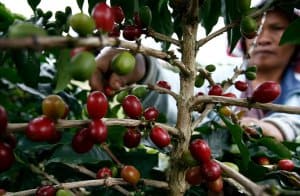
Moka Coffee: For those who love and have a brief understanding of coffee, indeed, Moka is a name that evokes aristocracy and elegance. This is because coffee Moka is considered the Queen of the coffee kingdom. So why does Moka have such a good name? What’s so particular about its taste?
Besides information about Moka Coffee, please refer to Bonjour Coffee’s overview of coffee knowledge if you are a coffee lover. This article helps you have an outline, which is the basis for a deeper understanding of coffee.
What is Moka Coffee?
Moka coffee is a type of Arabica coffee. Moka belongs to the same family as famous coffees such as Typica, Bourbon, Icatu, and Mundo Novo.
Moka was first found in a port city called Mocha in Yemen. Therefore, this coffee variety is also called Mocha Coffee. This type of coffee was first brought outside of Yemen in the last years of the 13th century. The missionary Marco Polo came here and brought Moka beans to sell in Europe.
However, it was not until the 17th century that Moka coffee beans became a wave and famous throughout Europe. When people mix it with Chocolate, it creates a Coffee – Chocolate flavor.
In the last years of the 19th century, around 1875, the French brought Moka seeds to grow in the northern provinces of Vietnam. Later, when they realized favorable climatic conditions, they opened large coffee plantations in the Central Highlands, especially in Cau Dat, Da Lat.
Moka coffee growing area in Vietnam
Since knowing about Moka coffee, Vietnamese people have developed this crop very early. However, no matter what measures are applied, nowhere brings the taste of Moka comparable to Da Lat. Especially planted and suitable for Cau Dat area with the famous Moka Cau Dat name.

Da Lat produces the best taste of Moka coffee because the climate and soil conditions here are highly favorable. With a geographical location from about 1500 – 2000m above sea level, it has a cool climate all year round. In addition, abundant rainfall, freshwater source, and especially red basalt soil help Moka coffee trees to grow best.
Features of Moka coffee
Compared to other Arabica varieties, Moka coffee is a complex plant to grow, prone to pests and diseases, and takes a lot of care. Therefore, it also has distinctive tree shape, fruit, and characteristic flavor features.
Biological characteristics of Moka coffee
Plants of the Moka coffee variety usually have a light gray body, and the roots go deep into the soil. Leaves are small, with few leaves, and symmetrical on both sides. Common Moka coffee trees will be somewhat meager less fruity than good seedlings because it is difficult to care for and prone to diseases.
Moka fruits are usually light green glossy when starting to ripen, gradually turning tomato red and dark red. The seeds of this coffee variety are typically small, round, not long, and flat.
Coffee flavor Moka
There must be something special in the taste for people to call Moka the Queen in the coffee kingdom. Those who know how to enjoy it will feel the difference the first time.
The best 100% original Moka coffee cups will bring a slightly bitter taste, mixed with a bit of sourness and the fatty taste of the oil inside the seeds. When drinking, the bitterness spreads in the mouth and down the throat, but the intense aroma and sweetness appear only a few seconds after.
Perhaps the Moka coffee tree is difficult to grow, requiring people to take a lot of care. However, the aroma and sweetness later result from perseverance and accurate processing. That is what makes the taste of Moka coffee unique in the world.
How to enjoy coffee Moka
There are two ways to make a good cup of Moka coffee: pure coffee powder and mixing it with other types. Each brewing method has unique flavors, but the taste of Moka coffee is still dominant.
Make pure Moka coffee.
If you want to know all the flavors of Moka, you should try a cup of 100% pure Moka.
You can use the Moka Pot, a specialized tool for making coffee to have a cup of coffee. Preparation is as follows:
- Add water to ½ Moka Pot.
- Put the filter cap on top and put Moka powder on it; use the lever to smooth the surface of the filter cap.
- Fit the top of the Moka Pot just tight enough, then bring it to a boil over the fire.
- When the water is hot, steam will rise to penetrate the Moka coffee powder, take out all the flavor and push the water up. Therefore, we will get a cup of 100% pure Moka coffee.
You can also make Moka using the Pour-over method to enjoy the coffee flavor fully.
Mix Moka coffee with other types of coffee cafe
Each type of coffee has a particular taste. To feel its deliciousness, we should mix it in a specific ratio.
Usually, 50% Moka, the other 50% Robusta, and a neutral compound. It can be mixed in the following proportions:
- 50% Moka, 40% Robusta, 10% Cocoa.
- 50% Moka, 20% Robusta, 20% Cherry, and 10% cocoa.
- Or you can mix 30% Moka, 60% Robusta, and 10% cocoa.
With the above ratios, you will get the perfect blend of flavors of coffee. There is the light taste of Moka, the bitterness of Robusta, and the sweetness of cocoa.
The new Moka coffee tree has reached the land God has destined for it through a long history. If prepared correctly, all the essence from the upstream water, the morning dew, the sunshine, and the wind of the Central Highlands will be in a natural cup of Moka coffee.
You can order Moka coffee at:
HELENA COFFEE PROCESSING & EXPORT
- Address: 124 Ngo Quyen, Buon Ma Thuot city, Vietnam
- Phone: +84.789.818.828 (Whatsapp/ Telegram)
- Email: helenacoffee.jsc@gmail.com
- Website: helenacoffee.vn